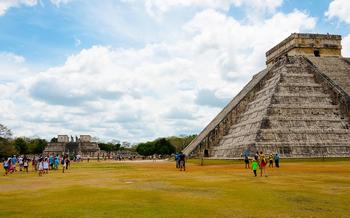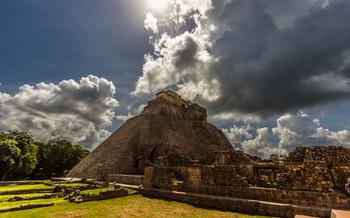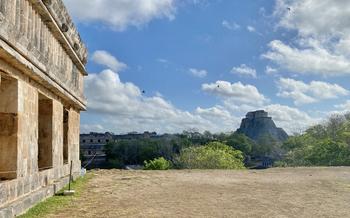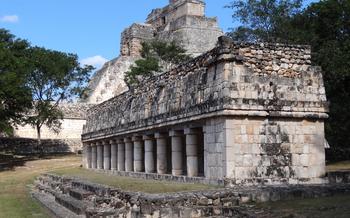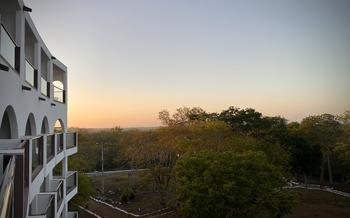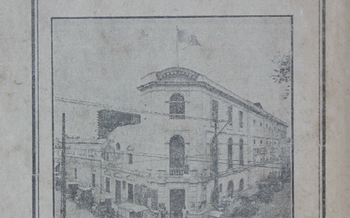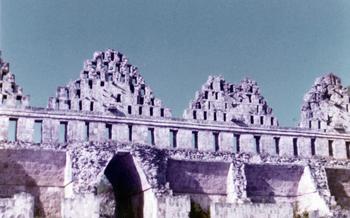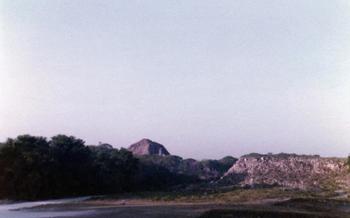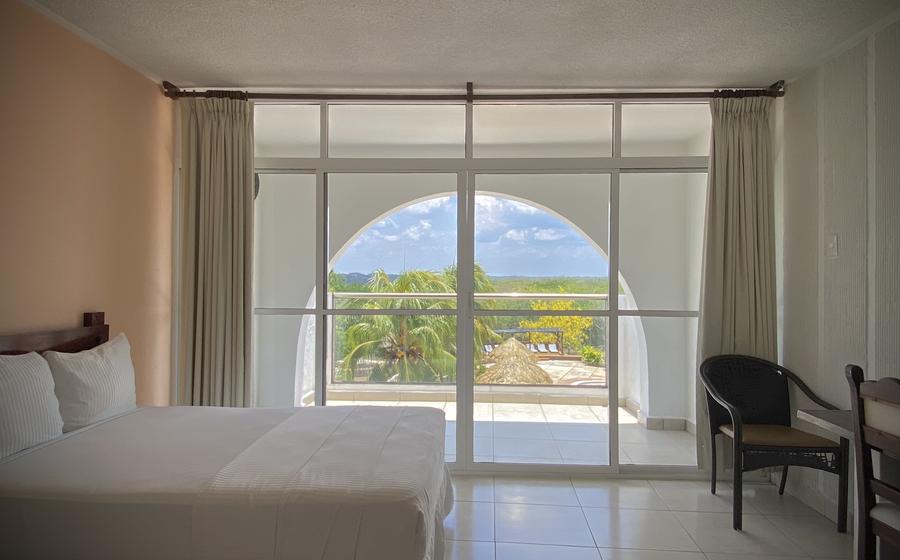
Xlapak Archaeological Site
- Uxmal, a Majestic City in the Maya Kingdom
- The Grand Plaza - Heart of Uxmal's Ceremonial Center
- The Pyramid of the Magician - An Architectural Masterpiece
- The Governor's Palace: A Showcase of Maya Elegance
- The Great Ball Court: A Place of Ritual and Competition
- The House of the Turtles: An Architectural Gem
- The Xlapak Archaeological Site: Exploring Beyond Uxmal's Ruins
- The Maya Writing System and Stelae at Uxmal
- The Puuc Route: Discover More Maya Treasures
- Flora and Fauna of Uxmal: Nature's Wonders
- Visiting Uxmal: Practical Information
- Cultural Experiences: Unveiling Maya Traditions
- Insider Tip: Unforgettable Sunset Views
Uxmal, a Majestic City in the Maya Kingdom
Uxmal, nestled within the Puuc region of Mexico's Yucatán Peninsula, stands as a testament to the grandeur of the ancient Maya civilization. Once a thriving metropolis, Uxmal's architectural masterpieces, intricate carvings, and rich history captivate visitors from around the world. Its well-preserved ruins, designated as a UNESCO World Heritage Site, offer a glimpse into the sophisticated urban planning, advanced mathematical knowledge, and artistic prowess of the Maya people.
Uxmal's strategic location amidst fertile lands and trade routes contributed to its rise as a prominent Maya city-state. Its influence extended far beyond its physical boundaries, with Uxmal serving as a political, economic, and cultural hub for the entire Puuc region. As one of the largest and most impressive Maya cities, Uxmal continues to inspire awe and wonder, inviting travelers to immerse themselves in the legacy of this ancient civilization.
The Grand Plaza - Heart of Uxmal's Ceremonial Center
The Grand Plaza, a sprawling expanse of stone paving, is the very core of Uxmal. It serves as the central gathering place, a stage for rituals, ceremonies, and astronomical observations. Surrounding this grand space are some of Uxmal's most notable structures, including the Governor's Palace and the Pyramid of the Magician.
The plaza's layout demonstrates the Maya's profound understanding of astronomy. It aligns with celestial events, such as the summer and winter solstices, enabling the Maya to accurately predict seasonal changes. This alignment suggests that the plaza was used for astronomical observations, allowing the Maya to plan their agricultural activities and religious ceremonies accordingly.
During its heyday, the plaza bustled with activity. Maya priests performed rituals, dancers twirled to the rhythm of sacred drums, and merchants displayed their wares. The plaza was a meeting place, a place for exchange, and a place where the community came together to celebrate and worship.
Today, the Grand Plaza stands as a testament to the Maya's ingenuity, their reverence for the cosmos, and their profound connection to the divine. It invites visitors to step back in time, to imagine the vibrant rituals and ceremonies that once filled this sacred space.
The Pyramid of the Magician - An Architectural Masterpiece
Standing tall and imposing at the heart of Uxmal, the Pyramid of the Magician is a testament to the Maya's architectural prowess. Rising 115 feet (35 meters) above the plaza, it dominates the skyline and commands attention with its sheer size and majesty. The pyramid's structure showcases the Maya's mastery of corbelled vaults, a technique that allowed them to create enclosed spaces without the use of arches or columns.
The pyramid's construction involved a series of terraces and platforms, gradually decreasing in size as they ascend. This design created a stepped appearance, with each level serving as a base for the next. The exterior of the pyramid is adorned with intricate carvings and sculptures, depicting various Maya deities and mythological scenes. These elaborate decorations provide a glimpse into the Maya's rich cultural and religious beliefs.
The pyramid's purpose extended beyond its architectural grandeur. It served as a temple, a sacred space for religious ceremonies and rituals. Its elevated position allowed Maya priests to commune with the gods and perform offerings to ensure the well-being of the community. The pyramid's construction also symbolized the power and authority of the Maya rulers and their connection to the divine realm.
Legends and myths surround the construction of the Pyramid of the Magician, adding to its mystique. One tale speaks of a dwarf magician who, with the help of his supernatural powers, built the pyramid in a single night. Another legend tells of a princess who was sacrificed at the pyramid's summit, ensuring its completion and granting it magical properties. These stories, passed down through generations, have further cemented the pyramid's place in Maya folklore and contributed to its enduring fascination.
The Governor's Palace: A Showcase of Maya Elegance
The Governor's Palace stands as a testament to the architectural prowess and artistic sensibility of the ancient Maya. Its imposing facade showcases intricate friezes and sculptures, narrating tales of power, history, and mythology. As the administrative center of Uxmal, the palace served as the seat of government, where rulers conducted affairs, received dignitaries, and held court.
Theories abound regarding the palace's original function. Some suggest it was the residence of the city's ruler, while others propose it served as a ceremonial center or a meeting place for the elite. Irrespective of its exact purpose, the palace exudes an aura of authority and grandeur, reflecting the wealth and influence of Uxmal's ruling class.
The palace's design embodies the quintessential Puuc style, characterized by its horizontal lines, corbelled arches, and elaborate ornamentation. The facade is adorned with a series of masks representing the rain god Chaac, symbolizing the Maya's deep reverence for water and agriculture. The building's intricate carvings depict scenes from Maya mythology and daily life, providing a glimpse into the rich cultural tapestry of this ancient civilization.
Within the palace's chambers, visitors can marvel at the well-preserved murals and paintings that once adorned its walls. These vibrant artworks depict Maya rulers, religious ceremonies, and scenes of daily life, offering a glimpse into the minds and beliefs of this enigmatic civilization.
The Governor's Palace stands as a testament to the Maya's architectural ingenuity, artistic prowess, and cultural sophistication. Its grandeur and elegance are a reminder of the power and influence that once emanated from this ancient Maya city.
The Great Ball Court: A Place of Ritual and Competition
Uxmal's Great Ball Court is a testament to the Maya's skill and passion for a ritualistic game that held deep cultural and religious significance. Measuring an impressive 150 meters in length and 70 meters in width, this ancient stadium-like structure served as a stage for a game that was more than just a sport.
The Maya ball game, known as pok-ta-pok, was a highly ritualized event played with a solid rubber ball and involved two teams competing to score by hitting the ball through stone hoops mounted high on the court walls. The game was not merely a contest of athleticism but also had profound religious and political undertones.
Victories were celebrated with feasts and offerings to the gods, while defeats could have serious consequences for the losing team's prestige and status. Spectators, often numbering in the thousands, would gather to witness these intense matches, which were accompanied by music, dance, and fervent chanting, creating an electrifying atmosphere.
Preservation efforts have been undertaken to maintain the integrity of the Great Ball Court at Uxmal. The site has been meticulously excavated and restored, allowing visitors to appreciate the grandeur of this ancient arena and imagine the spectacle of a Maya ball game unfolding before their eyes.
The House of the Turtles: An Architectural Gem
Amidst the grand structures of Uxmal, a lesser-known gem captivates the attention of visitors with its unique charm. The House of the Turtles, nestled within the sprawling ruins, stands out with its remarkable roof decoration featuring carved turtles. These intricately sculpted reptiles, arranged in rows, lend the building a distinctive character and a sense of mystery.
The turtle holds a significant place in Maya mythology and cosmology. Often associated with creation, fertility, and the underworld, the turtle represents the foundation upon which the world rests. Its presence on the roof of this building suggests a connection to these profound beliefs, imbuing the structure with sacred meaning.
Comparisons with other Maya sites reveal the significance of turtle motifs in Maya culture. At Chichén Itzá, the Temple of the Warriors features a turtle platform, while at Copán, Honduras, a similar motif adorns the Rosalila Temple. These parallels underscore the widespread reverence for the turtle among the ancient Maya.
Whether serving as a residential building or a ceremonial structure, the House of the Turtles remains a testament to the Maya's architectural prowess and their deep connection to the natural world. Its unique design and symbolic elements invite visitors to contemplate the rich tapestry of beliefs and traditions that shaped Maya civilization.
The Xlapak Archaeological Site: Exploring Beyond Uxmal's Ruins
Just a short distance from the grandeur of Uxmal lies the intriguing Xlapak archaeological site, an ancient Maya settlement that played a crucial role in supporting Uxmal's growth and prosperity. Xlapak served as a satellite site, providing essential resources and goods to the larger city.
At Xlapak, visitors can explore a fascinating complex of structures that reveal the site's diverse functions. Temples, palaces, and a ball court stand as testaments to Xlapak's religious, political, and social significance. The site's architecture showcases unique features, reflecting the influence of Uxmal's dominant style while maintaining its own distinct identity.
Archaeological evidence suggests that Xlapak played a vital role in trade and agriculture. Excavations have uncovered evidence of workshops and storage facilities, indicating the production and exchange of goods. The site's strategic location along trade routes allowed it to connect with other Maya cities and regions, contributing to the economic prosperity of Uxmal.
Ongoing archaeological research at Xlapak is shedding new light on its history and significance. Recent discoveries have revealed additional structures and artifacts, providing valuable insights into the daily lives and rituals of the ancient Maya who inhabited this site.
Visiting Xlapak offers a unique opportunity to explore beyond the iconic ruins of Uxmal and gain a deeper understanding of the interconnectedness of Maya cities. It is a chance to discover the hidden stories of the Maya civilization, where each site played a vital role in shaping the region's rich cultural heritage.
The Maya Writing System and Stelae at Uxmal
The Maya civilization developed a sophisticated writing system, one of the most advanced in pre-Columbian America. Their script consisted of a combination of logographic and syllabic symbols, allowing for the expression of complex ideas and historical narratives. Stelae, carved stone monuments, served as a primary medium for recording this written language.
At Uxmal, archaeologists have discovered several stelae, each bearing unique inscriptions that provide valuable insights into the site's history, politics, and religious beliefs. These monuments often commemorate important events, such as the accession of a new ruler or the completion of a major construction project. The texts on the stelae also shed light on the lineage and achievements of Uxmal's rulers, offering glimpses into the social and political hierarchy of the city.
The study of Maya stelae has played a crucial role in deciphering the Maya writing system and unlocking the secrets of their civilization. By carefully analyzing the inscriptions, scholars have gained a deeper understanding of Maya history, religion, and cultural practices. The stelae at Uxmal, along with those found at other Maya sites, stand as enduring testaments to the intellectual and artistic achievements of this ancient civilization.
The Puuc Route: Discover More Maya Treasures
Explore the Puuc Route, a circuit of ancient Maya sites that winds through the Yucatan Peninsula. Uxmal is a shining gem on this route, but many other captivating ruins await discovery. Kabah, with its grand palaces and elaborate masks, beckons with its own allure. Sayil, shrouded in mystery, invites you to decipher its hidden stories. Labna, with its graceful archways and intricate carvings, completes this trio of Puuc wonders.
Each site along the Puuc Route offers a unique glimpse into Maya history and culture. While Uxmal stands out for its sheer grandeur, Kabah's intricate facades and Sayil's enigmatic ruins provide a fascinating contrast. Labna's elegant architecture showcases the diversity of Puuc styles.
Venturing beyond Uxmal allows you to appreciate the broader context of Maya civilization. The Puuc Route reveals the interconnectedness of these ancient cities, each contributing to the rich tapestry of Maya culture. Whether you choose to visit one or several sites, the Puuc Route offers an unforgettable journey into the heart of the Maya world.
Flora and Fauna of Uxmal: Nature's Wonders
Uxmal's natural surroundings are as captivating as its ancient ruins. The region is home to a diverse array of plant and animal life, forming a vibrant ecosystem known as the tropical dry forest. This unique habitat supports a rich tapestry of flora and fauna that coexist harmoniously with the archaeological treasures.
Majestic trees, including towering ceiba and kapok, cast their shadows over the ancient city, providing shelter and sustenance to a myriad of creatures. Their twisted branches and sprawling canopies create a sense of awe and wonder, complementing the architectural marvels of Uxmal.
Within this verdant landscape, wildlife thrives. Birds of vibrant plumage flit through the trees, their melodious songs filling the air. Keep an eye out for colorful toucans, elegant woodpeckers, and the elusive ocellated turkey, a symbol of the Maya civilization.
Beneath the forest canopy, a diverse array of reptiles and amphibians make their home. Iguanas sun themselves on the ancient stones, while geckos scurry along the walls of the ruins, adding a touch of life to the historical structures.
Conservation efforts are underway to protect this fragile ecosystem and preserve the delicate balance between nature and culture. Visitors are encouraged to tread lightly, respecting the natural wonders that surround Uxmal.
Take the time to explore the trails that wind through the forest, immersing yourself in the beauty of the natural surroundings. Birdwatching enthusiasts can delight in the diverse avifauna, while nature lovers will appreciate the unique flora and fauna that call Uxmal home.
Visiting Uxmal: Practical Information
Getting There:
- Uxmal is easily accessible by car, with well-maintained roads leading to the site.
- Guided tours from major cities like Mérida and Cancún are readily available, offering transportation and informative commentary.
Entrance Fees and Facilities:
- Entrance fees are charged for visiting Uxmal, contributing to the site's conservation and maintenance.
- Guided tours are highly recommended, as they provide valuable insights into the history and significance of the ruins.
- Visitor facilities include restrooms, a museum, and a gift shop, ensuring a comfortable and informative experience.
Best Time to Visit:
- The best time to visit Uxmal is during the dry season, from November to April, when the weather is pleasant and dry.
- Aim to arrive early in the morning or late afternoon to avoid the midday heat and crowds, especially during peak tourist season.
Packing Essentials:
- Pack comfortable shoes for walking on uneven terrain.
- Bring a hat, sunglasses, and sunscreen to protect yourself from the tropical sun.
- Carry plenty of water to stay hydrated, as there are limited water sources within the site.
- Consider bringing insect repellent to ward off mosquitoes and other insects.
Precautions:
- Be aware of your surroundings and take necessary precautions to avoid theft or accidents.
- Respect the site's cultural significance by refraining from climbing or touching the ruins.
- Follow the designated trails to minimize damage to the archaeological remains.
- Refrain from using flash photography, as it can damage the ancient structures.
Cultural Experiences: Unveiling Maya Traditions
Uxmal offers visitors a chance to immerse themselves in the vibrant culture of the Maya people. Engage with local artisans who showcase their traditional crafts, such as weaving, pottery, and woodworking. Attend captivating dance performances that bring to life ancient Maya rituals and stories. Participate in storytelling sessions led by Maya elders, who share tales of their ancestors, their traditions, and their connection to the land.
When interacting with the Maya community, it's essential to be respectful of their customs and traditions. Dress modestly, avoid taking photos without permission, and always ask before entering someone's home or sacred space. By supporting sustainable tourism initiatives, you can contribute to the preservation of Maya culture and ensure that future generations can continue to benefit from its richness.
Give back to the local economy by purchasing souvenirs and handicrafts directly from artisans. Look for products that are made using traditional techniques and materials. This supports local livelihoods and helps to keep Maya traditions alive.
Remember, responsible travel is about respecting the local culture, environment, and people. Embrace the opportunity to learn about Maya traditions, ask questions, and share your experiences with others. By doing so, you'll create a meaningful connection with the Maya community and contribute to the preservation of their cultural heritage.
Insider Tip: Unforgettable Sunset Views
As the sun begins its descent, casting a warm glow over the ancient city, Uxmal transforms into a magical realm. This is the time to witness the true spectacle of Uxmal, as the setting sun illuminates the ruins, creating a breathtaking display of light and shadows. The golden hues bathe the structures, revealing intricate details and textures that are often hidden during the day.
For the most unforgettable experience, find a secluded spot within the site, perhaps atop one of the smaller pyramids or in a quiet corner of the Nunnery Quadrangle. As the sun dips towards the horizon, the sky erupts in a symphony of colors, from fiery reds and oranges to deep purples and blues. The ruins become a canvas for this celestial masterpiece, as the changing light transforms them into ever-shifting works of art.
This is also an ideal time for photography enthusiasts to capture the essence of Uxmal in all its glory. The soft, diffused light allows for stunning shots that showcase the ruins' architectural marvels against the backdrop of a colorful sky. Remember to adjust your camera settings accordingly and experiment with different angles to capture unique perspectives.
As the sun bids farewell, the ruins seem to come alive with a sense of mystery and enchantment. It's a moment to pause, reflect, and soak in the sheer beauty of this ancient city. With the crowds gone and the tranquility of the evening settling in, you'll have the opportunity to experience Uxmal in a way that is both unforgettable and deeply moving.
However, it's important to plan your visit accordingly, as the site has specific closing times. Make sure to arrive well in advance to fully appreciate the sunset spectacle and avoid any disappointment. Embracing this insider tip will undoubtedly elevate your Uxmal experience, leaving you with lasting memories of an enchanting journey through time.
